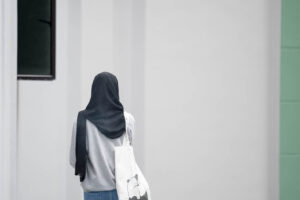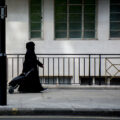Headscarf debate in Germany: Taking it off or putting it on?
Headscarf debate in Germany: Taking it off or putting it on?
The Islamic headscarf is a small piece of fabric with many levels of meaning. It can be interpreted differently by different communities in different countries. For that reason, a simple blanket ban does not solve all problems.
In recent years, Islamic headscarves have been a heated topic in public discourse all across Europe. The public debate on the Islamic headscarf in Germany began in 1998 with the case of Fereshta Ludin, a Muslim woman who was unable to work as a teacher in state schools in Baden-Württermberg because she wore a headscarf. [1] In 2003, the German Federal Constitutional Court (Bundesverfassungsgericht) issued a final ruling: federal states were in principle still allowed to keep or pass precautionary laws specifically banning on headscarves.[2] However, women like Ludin do not have to remove their headscarves while teaching in the absence of a “sufficiently precise legal basis.”[3] Outside the courtrooms, the debate continues unabated. To many, the headscarf is much more than just a piece of cloth.
Blanket bans on headscarves vs. freedom of religion
Different case, same topic: in 2006, two teachers accused the state of North Rhine-Westphalia of not hiring them because of their headscarves.[4] In 2015, the German Federal Constitutional Court issued an easily understandable and clear ruling on this issue: if there is no concrete danger to disrupting the peace at school or the state’s duty of neutrality, headscarves are permissible for women in the teaching profession.[5] Furthermore, the Court edited the 2003 ruling, adding: “The state may no longer ban Muslim teachers from headscarves as a blanket and precautionary measure.”[6] This decision concerned a total of eight federal states in which corresponding prohibition laws had applied, such as Berlin, North Rhine-Westphalia, and Bremen. They had to examine the amendments to their school laws carefully. [7] Since then, each federal state has developed different regulations on how to deal with headscarves in schools.[8]
Religious neutrality vs. freedom of religion
The 2015 ruling sparked massive criticism: some argued that the headscarf is a religious symbol and hence not religiously neutral, which is essentially against the concept of religious neutrality in state educational institutions and the public sphere.[9] Some considered the Islamic headscarf as a political statement – a symbol of the suppression of Muslim women or the lack of integration amongst people with an immigrant background.[10] For these reasons, many Germans believe the display of religious identity in public life and civil service domains should not be tolerated.
Headscarf is more than a religious symbol
However, interpretations of the headscarf as violations of religious neutrality are far from the only ways people view the issue. Headscarves can be intepreted differently by different Muslim communities in different countries: Islam is not equal to the headscarf. Wearing headscarves is not equivalent to a confession of Islamic faith. Similarly, not wearing headscarves does not necessarily mean emancipation or faithlessness.[11]
According to a survey conducted by the Federal Office for Migration and Refugees in 2016, around 70 percent of Muslim women in Germany do not wear a headscarf at all. Moreover, 50 percent of strongly religious Muslim women do not wear headscarves.[12] Beyond religion, it proves to be a symbol of identity, or a symbol of connection to the Muslim tradition and culture.[13]
Case-by-case decisions instead of blanket bans
Given the diversity of motivations for headscarves and the important liberties involved, a simple blanket ban does not solve all problems. The more careful case-by-case decisions would need to take the whole complexity of this discussion into consideration and might be a more productive solution. The enormous work and stress for courts and other concerned state institutions that this path will entail cannot be disputed. Nevertheless, the great good of humanity – human rights, in particular religious freedom in this case – speaks for taking this path and refraining from blanket bans on the headscarf issue.[14]
Han Chang
Want to know more about similar topics? Go to our EARS Dashboard and get free updates.
[1] Konfliktstoff Kopftuch | bpb
[2] Urteile – Karlsruhe korrigiert Kopftuchurteil von 2003 – Panorama – SZ.de
[3] Konfliktstoff Kopftuch | bpb; Verfassungsgericht: Lehrerin darf vorerst mit Kopftuch unterrichten – DER SPIEGEL
[4] Kopftuchstreit in NRW – Keine Entschädigung für muslimische Lehrerinnen
[5] Chefjurist kritisiert Kopftuchverbot wie Kopftuch gleichermaßen
[6] Presse – Ein pauschales Kopftuchverbot für Lehrkräfte in öffentlichen Schulen ist mit der Verfassung nicht vereinbar; Urteile – Karlsruhe korrigiert Kopftuchurteil von 2003 – Panorama – SZ.de
[7] Beschluss des Bundesverfassungsgerichts: Kopftuchverbot für Lehrerinnen gekippt
[8] Arbeitsgericht Berlin verbietet Lehrerin mit Kopftuch zu unterrichten – DER SPIEGEL; Kopftuchverbot an Schulen: So unterschiedlich sind die Regeln für Lehrerinnen – DER SPIEGEL
[9] Neues Kopftuchurteil – Eine Herausforderung für Schulen (Archiv) ; Ohne Kippa, Kreuz und Kopftuch – Das neutrale Klassenzimmer
[10] Kommentar: Kopftuch und Identität – Politik
[11] Wie eindimensionale Identitäten den Feminismus behindern; Verschleierungs-Debatte Was ist eigentlich eine Burka?; Zur aktuellen Kopftuchdebatte in Deutschland
[12] Muslimisches Leben in Deutschland






